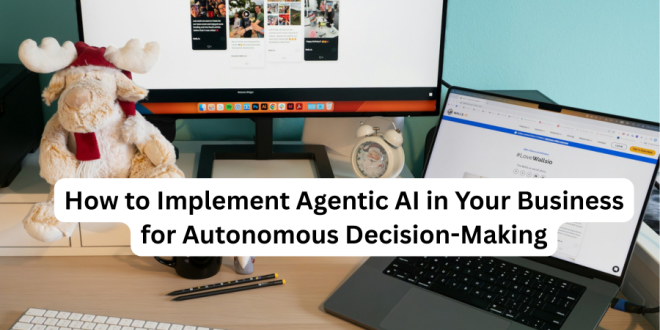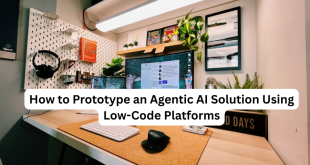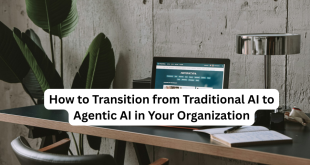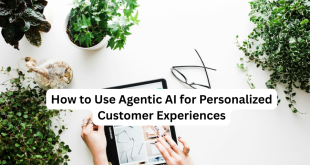Agentic AI—autonomous systems that make decisions and execute tasks with minimal human oversight—is revolutionizing how businesses operate. From automating inventory management to enhancing customer service, these intelligent agents are driving efficiency and innovation. If you’re ready to harness the power of agentic AI in your business, this step-by-step guide will walk you through the process, ensuring a smooth and impactful implementation.
What Is Agentic AI?
Before diving in, let’s clarify what agentic AI is. Unlike traditional AI, which relies on predefined rules or human prompts, agentic AI systems are proactive. They analyze data, make decisions, and act independently to achieve goals. Think of a virtual assistant that not only schedules meetings but also prioritizes them based on your business needs—or a logistics system that reroutes shipments in real time to avoid delays. Gartner predicts that by 2028, 15% of daily work decisions will be made autonomously, making now the perfect time to adopt this technology.
Step 1: Define Your Business Goals
Start by identifying where agentic AI can add the most value. Ask yourself:
- Which repetitive or complex tasks consume significant time or resources?
- Are there decision-making processes that could be faster or more data-driven?
- What are your key performance indicators (KPIs) for success?
For example, an e-commerce business might use agentic AI to optimize inventory by predicting demand and restocking autonomously. A customer service team could deploy AI agents to handle routine inquiries, freeing staff for complex issues. Clear goals will guide your implementation and help measure impact.
Action Item: Create a list of 3-5 processes where automation could save time or improve outcomes. Prioritize one for your initial project.
Step 2: Assess Your Data and Infrastructure
Agentic AI thrives on data. To make informed decisions, AI agents need access to high-quality, real-time data. Evaluate your current systems:
- Do you have clean, structured data (e.g., sales records, customer interactions)?
- Are your systems integrated (e.g., CRM, ERP, or IoT devices)?
- Can your infrastructure support AI workloads, or do you need cloud solutions?
If your data is scattered or outdated, invest in data cleaning and integration tools. Cloud platforms like AWS, Google Cloud, or Microsoft Azure offer scalable infrastructure for AI deployment, often with pre-built agentic AI frameworks.
Action Item: Audit your data sources and ensure they’re accessible via APIs or centralized databases. Consider consulting a data engineer if needed.
Step 3: Choose the Right Agentic AI Platform
The market offers a range of agentic AI tools tailored to different needs and budgets. Some popular options include:
- Enterprise Solutions: IBM Watson, Microsoft Copilot, or Salesforce Einstein provide robust, industry-specific AI agents with built-in integrations.
- Open-Source Frameworks: LangChain or AutoGen allow developers to build custom AI agents, ideal for businesses with technical expertise.
- Low-Code Platforms: Tools like UiPath or Zapier with AI extensions enable non-technical teams to create autonomous workflows.
When selecting a platform, consider:
- Compatibility with your existing tech stack.
- Scalability for future growth.
- Vendor support and community resources.
Action Item: Research 2-3 platforms and request demos or trials. For small businesses, start with affordable options like Google Cloud AI or open-source tools.
Step 4: Develop or Customize Your AI Agent
Once you’ve chosen a platform, it’s time to build or configure your AI agent. This involves:
- Defining the Agent’s Role: Specify tasks (e.g., “monitor inventory and reorder when stock falls below 20%”) and decision-making boundaries (e.g., “escalate to a human for orders over $10,000”).
- Training the Model: Feed the agent relevant data to learn patterns and refine its decision-making. For example, historical sales data can train an inventory agent.
- Testing in a Sandbox: Run simulations to ensure the agent performs as expected without disrupting operations.
If you lack in-house expertise, partner with an AI consultant or vendor to streamline this process. Many platforms offer pre-trained models that require minimal customization.
Action Item: Work with your IT team or vendor to prototype your agent. Test it on a small scale (e.g., one product line or department) before full deployment.
Step 5: Deploy and Monitor the AI Agent
Launch your AI agent in a controlled environment, such as a single department or process. Monitor its performance closely:
- Track KPIs: Measure time saved, cost reductions, or accuracy improvements.
- Gather Feedback: Ask employees and customers how the agent impacts their experience.
- Address Issues: Fix bugs or retrain the model if decisions deviate from expectations.
Use monitoring tools like Datadog or built-in platform dashboards to track real-time performance. Be prepared to iterate—agentic AI improves with feedback and data.
Action Item: Set up a weekly review for the first month to analyze performance and make adjustments.
Step 6: Scale and Optimize
Once your pilot project succeeds, expand agentic AI to other areas. For example, an e-commerce business might extend AI from inventory to personalized marketing or returns processing. Optimize by:
- Integrating with additional data sources (e.g., social media trends for demand forecasting).
- Automating more complex decisions as the agent learns.
- Training staff to collaborate with AI, ensuring a human-in-the-loop approach for critical tasks.
Action Item: Plan a 6-month roadmap to scale AI across 1-2 additional processes, budgeting for training and infrastructure upgrades.
Overcoming Common Challenges
Implementing agentic AI isn’t without hurdles. Here’s how to tackle them:
- Resistance to Change: Educate employees on AI’s benefits and involve them in the process to build trust.
- Ethical Concerns: Establish clear guidelines to prevent bias and ensure transparency in AI decisions.
- Cost: Start small with cloud-based or open-source solutions to minimize upfront investment.
Measuring ROI
To justify your investment, calculate ROI by comparing costs (development, subscriptions, training) against gains (time saved, revenue growth, error reduction). For instance, a logistics company using agentic AI to optimize routes might save 20% on fuel costs, translating to thousands in annual savings.
Conclusion
Agentic AI is a game-changer for businesses seeking efficiency and innovation. By defining clear goals, leveraging the right tools, and iterating based on performance, you can implement autonomous decision-making that transforms your operations. Start small, monitor closely, and scale strategically to unlock the full potential of this technology.
Ready to take the plunge? Audit your processes today and explore platforms like Microsoft Azure or LangChain to kickstart your agentic AI journey. Share your experiences or questions in the comments below—we’d love to hear how you’re embracing this exciting tech!
 UBUCH ubuch | Honest Tech Reviews & Tutorials for Everyone
UBUCH ubuch | Honest Tech Reviews & Tutorials for Everyone




